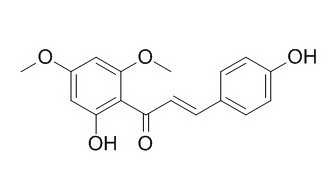Flavokawain C
Flavokawain C is a melanogenesis inhibitor, it inhibited melanogenesis with IC50 values of 6.9 uM. Flavokawain C has anti-tumor activity, it inhibited cell cycle and promoted apoptosis, associated with endoplasmic reticulum stress and regulation of MAPKs and Akt signaling pathways in HCT 116 human colon carcinoma cells.
Inquire / Order:
manager@chemfaces.com
Technical Inquiries:
service@chemfaces.com
Tel:
+86-27-84237783
Fax:
+86-27-84254680
Address:
1 Building, No. 83, CheCheng Rd., Wuhan Economic and Technological Development Zone, Wuhan, Hubei 430056, PRC
Providing storage is as stated on the product vial and the vial is kept tightly sealed, the product can be stored for up to
24 months(2-8C).
Wherever possible, you should prepare and use solutions on the same day. However, if you need to make up stock solutions in advance, we recommend that you store the solution as aliquots in tightly sealed vials at -20C. Generally, these will be useable for up to two weeks. Before use, and prior to opening the vial we recommend that you allow your product to equilibrate to room temperature for at least 1 hour.
Need more advice on solubility, usage and handling? Please email to: service@chemfaces.com
The packaging of the product may have turned upside down during transportation, resulting in the natural compounds adhering to the neck or cap of the vial. take the vial out of its packaging and gently shake to let the compounds fall to the bottom of the vial. for liquid products, centrifuge at 200-500 RPM to gather the liquid at the bottom of the vial. try to avoid loss or contamination during handling.
Appl Biol Chem2019, 62:46
Biomed Pharmacother.2021, 139:111585.
Int Immunopharmacol.2024, 143(Pt 2):113486.
Drug Des Devel Ther.2020, 14:969-976.
Front Aging Neurosci.2018, 10:269
Int J Mol Sci.2022, 23(11):6172.
Evid Based Complement Alternat Med.2022, 9767292,2.
J Liq Chromatogr R T2025, 2505536.
Biochem Pharmacol.2017, 130:10-20
Biomedicines.2020, 8(11):486.
Related and Featured Products
Cancer Cell International 2013, 13:102
The flavokawains: uprising medicinal chalcones[Reference:
WebLink]
Plant-based compounds have been in the spotlight in search of new and promising drugs.
METHODS AND RESULTS:
Flavokawain A, Flavokawain B and Flavokawain C
are naturally occurring chalcones that have been isolated from several medicinal plants; namely the piper
methysticum or commercially known as the kava-kava. Multiple researches have been done to evaluate the
bioactivities of these compounds. It has been shown that all three flavokawains may hold promising anti-cancer
effects. It has also been revealed that both flavokawain A and Flavokawain B are involved in the induction of cell cycle arrest in
several cancer cell lines. Nevertheless, flavokawain B was shown to be more effective in treating in vitro cancer cell
lines as compared to flavokawain A and Flavokawain C. Flavokawain B also exerts antinociceptive effects as well as antiinflammation
properties.
CONCLUSIONS:
This mini-review attempts to discuss the biological properties of all the flavokawains that
have been reported
Bioorg Med Chem Lett. 2015 Feb 15;25(4):799-802.
Flavokawains B and C, melanogenesis inhibitors, isolated from the root of Piper methysticum and synthesis of analogs.[Pubmed:
25597012]
The ethanolic extract of the root of Piper methysticum was found to inhibit melanogenesis in MSH-activated B16 melanoma cells.
METHODS AND RESULTS:
Flavokawain B and Flavokawain C were isolated from this extract based on their anti-melanogenesis activity and found to inhibit melanogenesis with IC50 values of 7.7μM and 6.9μM, respectively. Flavokawain analogs were synthesized through a Claisen-Schmidt condensation of their corresponding acetophenones and benzaldehydes and were evaluated in terms of their tyrosinase inhibitory and anti-melanogenesis activities.
CONCLUSIONS:
Compound 1b was the most potent of these with an IC50 value of 2.3μM in melanogenesis inhibition assays using MSH-activated B16 melanoma cells.
PLoS One. 2016 Feb 9;11(2):e0148775.
Flavokawain C Inhibits Cell Cycle and Promotes Apoptosis, Associated with Endoplasmic Reticulum Stress and Regulation of MAPKs and Akt Signaling Pathways in HCT 116 Human Colon Carcinoma Cells.[Pubmed:
26859847 ]
Flavokawain C (FKC) is a naturally occurring chalcone which can be found in Kava (Piper methysticum Forst) root. The present study evaluated the effect of FKC on the growth of various human cancer cell lines and the underlying associated mechanisms.
METHODS AND RESULTS:
FKC showed higher cytotoxic activity against HCT 116 cells in a time- and dose-dependent manner in comparison to other cell lines (MCF-7, HT-29, A549 and CaSki), with minimal toxicity on normal human colon cells. The apoptosis-inducing capability of FKC on HCT 116 cells was evidenced by cell shrinkage, chromatin condensation, DNA fragmentation and increased phosphatidylserine externalization. FKC was found to disrupt mitochondrial membrane potential, resulting in the release of Smac/DIABLO, AIF and cytochrome c into the cytoplasm. Our results also revealed that FKC induced intrinsic and extrinsic apoptosis via upregulation of the levels of pro-apoptotic proteins (Bak) and death receptors (DR5), while downregulation of the levels of anti-apoptotic proteins (XIAP, cIAP-1, c-FlipL, Bcl-xL and survivin), resulting in the activation of caspase-3, -8 and -9 and cleavage of poly(ADP-ribose) polymerase (PARP). FKC was also found to cause endoplasmic reticulum (ER) stress, as suggested by the elevation of GADD153 protein after FKC treatment. After the cells were exposed to FKC (60μM) over 18hrs, there was a substantial increase in the phosphorylation of ERK 1/2. The expression of phosphorylated Akt was also reduced. FKC also caused cell cycle arrest in the S phase in HCT 116 cells in a time- and dose-dependent manner and with accumulation of cells in the sub-G1 phase. This was accompanied by the downregulation of cyclin-dependent kinases (CDK2 and CDK4), consistent with the upregulation of CDK inhibitors (p21Cip1 and p27Kip1), and hypophosphorylation of Rb.



